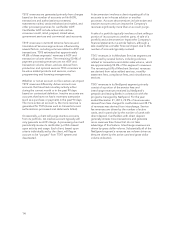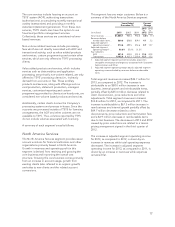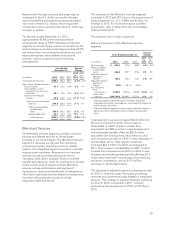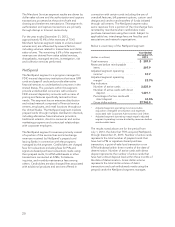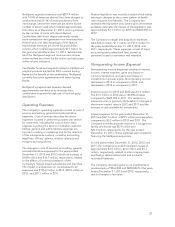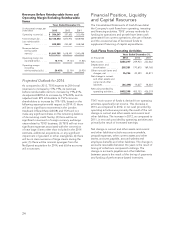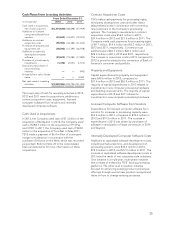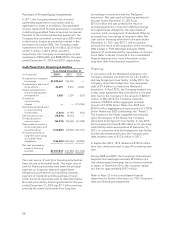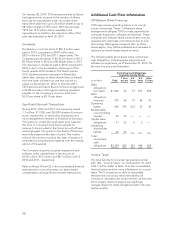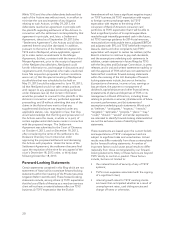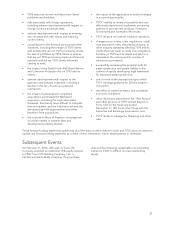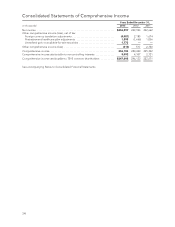NetSpend 2013 Annual Report Download - page 26
Download and view the complete annual report
Please find page 26 of the 2013 NetSpend annual report below. You can navigate through the pages in the report by either clicking on the pages listed below, or by using the keyword search tool below to find specific information within the annual report.
Revenues Before Reimbursable Items and
Operating Margin Excluding Reimbursable
Items
Years Ended December 31,
(in thousands except per
share data) 2013 2012 2011
Operating income (a) . . . $ 386,247 357,652 322,456
Total revenues (b) ...... $2,132,353 1,870,972 1,808,966
Less reimbursable
items ............... 240,598 252,481 268,268
Revenues before
reimbursable
items (c) ............ $1,891,755 1,618,491 1,540,698
Operating margin (as
reported) (a)/(b) ...... 18.11% 19.12% 17.83%
Operating margin
excluding
reimbursables (a)/(c) . . 20.42% 22.10% 20.93%
Projected Outlook for 2014
As compared to 2013, TSYS expects its 2014 total
revenues to increase by 17%-19%, its revenues
before reimbursable items to increase by 19%-21%,
its adjusted EBITDA to increase by 17%-20%, and its
adjusted cash EPS attributable to TSYS common
shareholders to increase by 11%-13%, based on the
following assumptions with respect to 2014: (1) there
will be no significant movements in the London
Interbank Offered Rate (LIBOR) and TSYS will not
make any significant draws on the remaining balance
of its revolving credit facility; (2) there will be no
significant movement in foreign currency exchange
rates related to TSYS’ business; (3) TSYS will not incur
significant expenses associated with the conversion
of new large clients other than included in the 2014
estimate, additional acquisitions, or any significant
impairment of goodwill or other intangibles; (4) there
will be no deconversions of large clients during the
year; (5) there will be minimal synergies from the
NetSpend acquisition for 2014; and (6) the economy
will not worsen.
Financial Position, Liquidity
and Capital Resources
The Consolidated Statements of Cash Flows detail
the Company’s cash flows from operating, investing
and financing activities. TSYS’ primary methods for
funding its operations and growth have been cash
generated from current operations, the use of leases
and the occasional use of borrowed funds to
supplement financing of capital expenditures.
Cash Flows from Operating Activities
Years Ended December 31,
(in thousands) 2013 2012 2011
Net income ............ $256,597 249,923 222,662
Depreciation and
amortization ......... 205,351 170,610 169,165
Other noncash items and
charges, net ......... 76,744 20,593 25,811
Net change in current
and other assets and
current and other
liabilities ............ (86,294) 14,627 18,681
Net cash provided by
operating activities .... $452,398 455,753 436,319
TSYS’ main source of funds is derived from operating
activities, specifically net income. The decrease in
2013, as compared to 2012, in net cash provided by
operating activities was primarily the result of the net
change in current and other assets and current and
other liabilities. The increase in 2012, as compared to
2011, in net cash provided by operating activities was
primarily the result of increased earnings.
Net change in current and other assets and current
and other liabilities include accounts receivable,
prepaid expenses, other current assets and other
assets, accounts payable, accrued salaries and
employee benefits and other liabilities. The change in
accounts receivable between the years is the result of
timing of collections compared to billings. The
change in accounts payable and other liabilities
between years is the result of the timing of payments
and funding of performance-based incentives.
24


